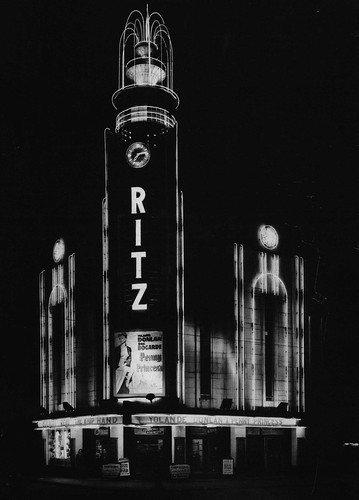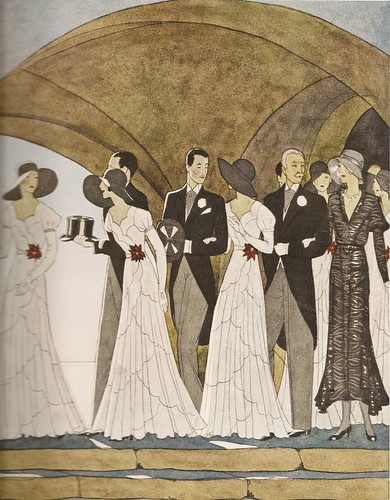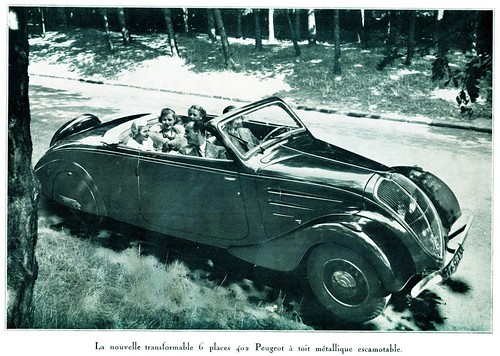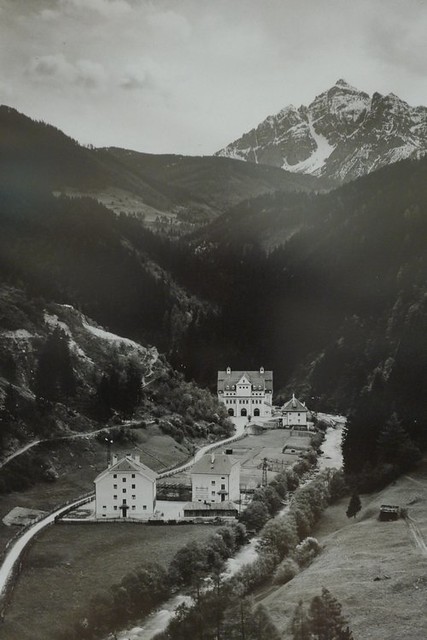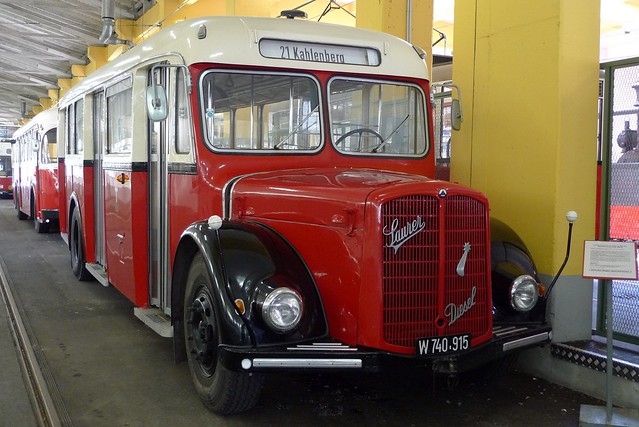Saturday, July 31, 2010
Friday, July 30, 2010
Aviator
 Monument to Francesco Baracca,
Monument to Francesco Baracca,WWI ace, Italy's national hero.
Lugo, Emilia Romagna
Designed by Domenico Rambelli
Opened in 1936
Let's Go to the Movies
Thursday, July 29, 2010
Super Coach
 Designed by Dwight E. Austin and financed by Greyhound, the Model 719 "Super Coach" with transverse rear engine and under-floor luggage space brought a new standard of passenger comfort to the intercity bus industry.
Designed by Dwight E. Austin and financed by Greyhound, the Model 719 "Super Coach" with transverse rear engine and under-floor luggage space brought a new standard of passenger comfort to the intercity bus industry. Through a number of modifications the 719 developed into the diesel-powered, air-conditioned "Silversides," of which almost 2500 were placed into Greyhound service between 1940 and 1948, and then into 41-passenger postwar versions that introduced the 6-71 diesel to many over-the-road carriers.
Through a number of modifications the 719 developed into the diesel-powered, air-conditioned "Silversides," of which almost 2500 were placed into Greyhound service between 1940 and 1948, and then into 41-passenger postwar versions that introduced the 6-71 diesel to many over-the-road carriers.  Torque converter drive was not used, because it offered poor fuel economy at highway speeds.
Torque converter drive was not used, because it offered poor fuel economy at highway speeds.Wednesday, July 28, 2010
Wedding in Style
French Art Deco Wedding,
originally uploaded by MsBlueSky
Artwork by Andre Edouard Marty,
published in Harper's Bazaar (1930)
originally uploaded by MsBlueSky
Artwork by Andre Edouard Marty,
published in Harper's Bazaar (1930)
Tuesday, July 27, 2010
Monday, July 26, 2010
White Mars
Mars was a factory for iron ovens in Nuremberg / Germany and later also built bicycles. In 1903 the company started to produce motorcycles and automobiles. Automobile production remained a brief episode which already ended in 1908. The manufacturing of motorcycles, however, was continued until the middle of the 1920s.
 The most famous model was the legendary “White Mars” (model A20). It was designed in 1920 by Claus Franzenberg and built until 1925. The air-cooled engine has a displacement of 956 ccm and an output of approx. 8 hp. The frame is made of welded and bolted sheet-steel. The motorcycle weighs about 140 kg and reaches a maximum speed of approx. 90 km/h. A striking feature is the starting-handle which is required for starting of the engine.
The most famous model was the legendary “White Mars” (model A20). It was designed in 1920 by Claus Franzenberg and built until 1925. The air-cooled engine has a displacement of 956 ccm and an output of approx. 8 hp. The frame is made of welded and bolted sheet-steel. The motorcycle weighs about 140 kg and reaches a maximum speed of approx. 90 km/h. A striking feature is the starting-handle which is required for starting of the engine.
 This fantastic machine, a milestone of motorcycle history, was powered by a 2-cylinder transverse boxer engine designed by Franzenberg and manufactured by Maybach in Friedrichshafen exclusively for Mars.
This fantastic machine, a milestone of motorcycle history, was powered by a 2-cylinder transverse boxer engine designed by Franzenberg and manufactured by Maybach in Friedrichshafen exclusively for Mars.
 The most famous model was the legendary “White Mars” (model A20). It was designed in 1920 by Claus Franzenberg and built until 1925. The air-cooled engine has a displacement of 956 ccm and an output of approx. 8 hp. The frame is made of welded and bolted sheet-steel. The motorcycle weighs about 140 kg and reaches a maximum speed of approx. 90 km/h. A striking feature is the starting-handle which is required for starting of the engine.
The most famous model was the legendary “White Mars” (model A20). It was designed in 1920 by Claus Franzenberg and built until 1925. The air-cooled engine has a displacement of 956 ccm and an output of approx. 8 hp. The frame is made of welded and bolted sheet-steel. The motorcycle weighs about 140 kg and reaches a maximum speed of approx. 90 km/h. A striking feature is the starting-handle which is required for starting of the engine. This fantastic machine, a milestone of motorcycle history, was powered by a 2-cylinder transverse boxer engine designed by Franzenberg and manufactured by Maybach in Friedrichshafen exclusively for Mars.
This fantastic machine, a milestone of motorcycle history, was powered by a 2-cylinder transverse boxer engine designed by Franzenberg and manufactured by Maybach in Friedrichshafen exclusively for Mars.Sunday, July 25, 2010
Saturday, July 24, 2010
Viennese Tramways
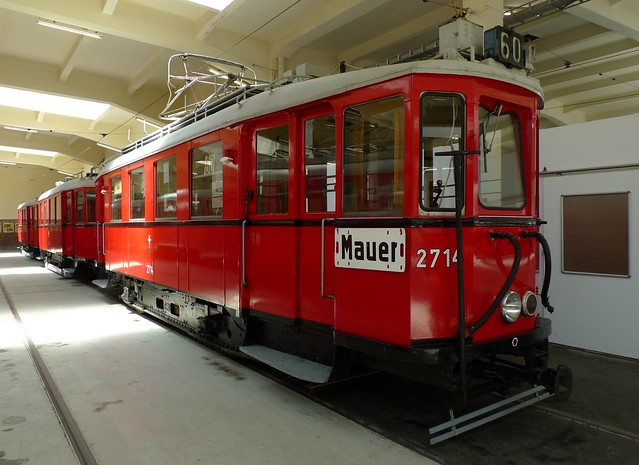 N/n Type was the most technically advanced streetcar in the interbellum Vienna. It was a development of the pre-WWI type designed for Pressburg (today Bratislava). Otto Wagner, the greatest Austrian architect, took part in the Pressburg project.
N/n Type was the most technically advanced streetcar in the interbellum Vienna. It was a development of the pre-WWI type designed for Pressburg (today Bratislava). Otto Wagner, the greatest Austrian architect, took part in the Pressburg project. In 1925 Vienna Municipality ordered 330 N/n type streetcars.
In 1925 Vienna Municipality ordered 330 N/n type streetcars.That's how they looked like in 1927 and 1929.
 After the WWII the type underwent extensive modernization. The cars were fitted with brand-new bodywork but retained their original platforms and engines. This train, N1 - n2 - N1, was rebuilt in 1954.
After the WWII the type underwent extensive modernization. The cars were fitted with brand-new bodywork but retained their original platforms and engines. This train, N1 - n2 - N1, was rebuilt in 1954.Tramway Museum, Vienna
photo by Lord K
Friday, July 23, 2010
Thursday, July 22, 2010
Wednesday, July 21, 2010
Tuesday, July 20, 2010
Monday, July 19, 2010
Wartime Zündapps
 Zündapp KS 750 was a German Army motorcycle that met the following criteria:
Zündapp KS 750 was a German Army motorcycle that met the following criteria:• Ability to carry a payload of 500kg (1,102.3lb), the equivalent of three fully equipped soldiers, including arms and ammo.
• It had to cruise at 80kmh (not quite 50mph) and be able to reach 95kmh (not quite 60mph) but also be able to crawl along at 3mph so as not to run over marching troops.
• The tires had to be 5.00in x 16in.
• Minimum ground clearance had to be 150mm (6in) and there had to be enough room under the fenders for snow chains.
 Pictures taken by Lord K at the Auf Rädern und Ketten (On Wheels & Tracks) event, Military Museum, Vienna, Austria
Pictures taken by Lord K at the Auf Rädern und Ketten (On Wheels & Tracks) event, Military Museum, Vienna, AustriaSunday, July 18, 2010
Saturday, July 17, 2010
Little Wing, Soviet Style
 KHAI-3 (KhAI-Aviavnito-3 "Sergei Kirov") flying wing, designed by A. Lazarev and A. Krol, was first flown at September 23, 1936 (pilot E. Schwarz). In 1937-38 it served at some local routes around Moscow carrying cargo and passengers, being the world’s first flying wing really used as transport aircraft!.
KHAI-3 (KhAI-Aviavnito-3 "Sergei Kirov") flying wing, designed by A. Lazarev and A. Krol, was first flown at September 23, 1936 (pilot E. Schwarz). In 1937-38 it served at some local routes around Moscow carrying cargo and passengers, being the world’s first flying wing really used as transport aircraft!.Friday, July 16, 2010
Wednesday, July 14, 2010
Saturday, July 10, 2010
Mille Miglia, 750 cc
A genuine piece of the Mille Miglia history, this unique sportscar has a stunning background and its existence has been totally characterized by the its entries at the 1948 and 1950 editions, driven by Mr. Baravelli and Mr. Pomes from Scuderia Lazio; then, in 1998, 1999, 2004 and 2008 this nice italian "barchetta" has been one of the protagonists of the evocative and exclusive event starting from Brescia!
Beginning its life as a Fiat 500 A on 23 April 1937, our chassis n.15526 was bought with the actual black plate ROMA 65032, by Signor Melchiorre Pomes of Rome in February 1947; he decided to build up a MM racing sportscar, using the mechanical and engineering support of the Officina Fratelli Giannini and the experience of the Carrozzeria Ala d'Oro to make a perfect bodywork of a "tipo siluro" prototype. The car was then accepted in the Sport 750 Class and it run the 1948 MM with nr.97 (retired), driven by Signor Giulio Baravelli. In 1950, Mr.Pomes decided to change the small 660 engine into a more powerful Giannini G1 unit with a capacity of 743 cc, a Marino alloy head and a three bearings support; this is actual configuration of this "one off" example, which was entered in the Mille Miglia race of 1950 (entry nr. 314).
Friday, July 9, 2010
Duchess of Hamilton
 Preserved British steam locomotive of the former London, Midland and Scottish (LMS) Railway, Princess Coronation Class No. 6229 Duchess of Hamilton.
Preserved British steam locomotive of the former London, Midland and Scottish (LMS) Railway, Princess Coronation Class No. 6229 Duchess of Hamilton.The locomotive was built as a streamliner in 1938 in a blue and silver livery, and was exported to the United States (painted as Class sister No. 6220) for a 3,000 mile tour and visit to the 1939 New York World's Fair, before returning in 1942. The streamlining was removed in 1947 for ease of maintenance. She was re-streamlined in 2009 and put on display at the National Railway Museum in York.
Via Larry @ Dieselpunks.org aka Dieselpunk 44
Wednesday, July 7, 2010
Tuesday, July 6, 2010
Now and Then
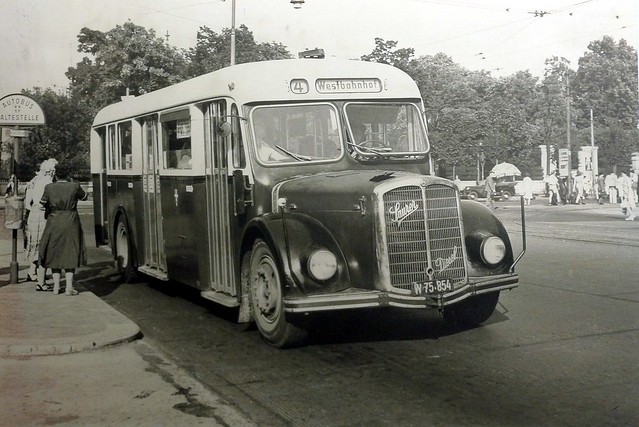 Images: Lord K and Vienna Tramway Museum
Images: Lord K and Vienna Tramway MuseumMonday, July 5, 2010
Japanese cruiser Yūbari
Yūbari was a single light cruiser built between 1922 and 1923 for the Imperial Japanese Navy. She fought in World War II and was sunk by the US navy.
 This ship represents the beginning of all 'modern' Japanese cruiser design. She was originally laid down as an experimental cruiser under the guidance of Yuzuru Hiraga, the most famous Japanese naval architect of his time. Yubari presented quite a radical appearance with her combined, swept-back main funnel and clipper bow. She served as a prototype for the forthcoming Furutaka, which incorporated many of Hiraga's ideas concerning weight reduction and cramming the maximum firepower into a given displacement.
This ship represents the beginning of all 'modern' Japanese cruiser design. She was originally laid down as an experimental cruiser under the guidance of Yuzuru Hiraga, the most famous Japanese naval architect of his time. Yubari presented quite a radical appearance with her combined, swept-back main funnel and clipper bow. She served as a prototype for the forthcoming Furutaka, which incorporated many of Hiraga's ideas concerning weight reduction and cramming the maximum firepower into a given displacement.
 The ship was completed 419 t (412 long tons) (13%) over the designed displacement, this resulted in an extra foot of draft and a loss of 1.5 kn (2.8 km/h; 1.7 mph) in designed speed. The ship was considered successful, however, and many of its features were used in subsequent Japanese warships.
The ship was completed 419 t (412 long tons) (13%) over the designed displacement, this resulted in an extra foot of draft and a loss of 1.5 kn (2.8 km/h; 1.7 mph) in designed speed. The ship was considered successful, however, and many of its features were used in subsequent Japanese warships.
 The ship had a significant refit in early 1944 when the two single 140 mm (5.5 in) guns were removed, one 120 mm (4.7 in) AA gun (in the "A" position) and six twin and one triple 25 mm (0.98 in) AA guns were added together with a search radar and depth charges.
The ship had a significant refit in early 1944 when the two single 140 mm (5.5 in) guns were removed, one 120 mm (4.7 in) AA gun (in the "A" position) and six twin and one triple 25 mm (0.98 in) AA guns were added together with a search radar and depth charges.
Yubari served in the Pacific during World War II where she was the flagship of the Japanese invasion force during the invasion of Wake Island. She led both invasion attempts on 11 and 23 December 1941 and was damaged by US Marine coastal guns during the first attempted landing. Yubari was sunk on 27 April 1944 off Palau by the US submarine Bluegill.
 This ship represents the beginning of all 'modern' Japanese cruiser design. She was originally laid down as an experimental cruiser under the guidance of Yuzuru Hiraga, the most famous Japanese naval architect of his time. Yubari presented quite a radical appearance with her combined, swept-back main funnel and clipper bow. She served as a prototype for the forthcoming Furutaka, which incorporated many of Hiraga's ideas concerning weight reduction and cramming the maximum firepower into a given displacement.
This ship represents the beginning of all 'modern' Japanese cruiser design. She was originally laid down as an experimental cruiser under the guidance of Yuzuru Hiraga, the most famous Japanese naval architect of his time. Yubari presented quite a radical appearance with her combined, swept-back main funnel and clipper bow. She served as a prototype for the forthcoming Furutaka, which incorporated many of Hiraga's ideas concerning weight reduction and cramming the maximum firepower into a given displacement. The ship was completed 419 t (412 long tons) (13%) over the designed displacement, this resulted in an extra foot of draft and a loss of 1.5 kn (2.8 km/h; 1.7 mph) in designed speed. The ship was considered successful, however, and many of its features were used in subsequent Japanese warships.
The ship was completed 419 t (412 long tons) (13%) over the designed displacement, this resulted in an extra foot of draft and a loss of 1.5 kn (2.8 km/h; 1.7 mph) in designed speed. The ship was considered successful, however, and many of its features were used in subsequent Japanese warships. The ship had a significant refit in early 1944 when the two single 140 mm (5.5 in) guns were removed, one 120 mm (4.7 in) AA gun (in the "A" position) and six twin and one triple 25 mm (0.98 in) AA guns were added together with a search radar and depth charges.
The ship had a significant refit in early 1944 when the two single 140 mm (5.5 in) guns were removed, one 120 mm (4.7 in) AA gun (in the "A" position) and six twin and one triple 25 mm (0.98 in) AA guns were added together with a search radar and depth charges.Yubari served in the Pacific during World War II where she was the flagship of the Japanese invasion force during the invasion of Wake Island. She led both invasion attempts on 11 and 23 December 1941 and was damaged by US Marine coastal guns during the first attempted landing. Yubari was sunk on 27 April 1944 off Palau by the US submarine Bluegill.
Sources: Wiki (EN), Furashita's Fleet
Saturday, July 3, 2010
Friday, July 2, 2010
Italian Giant
The Caproni Ca.90 was a prototype Italian heavy bomber designed and built by Caproni. When it first flew in 1929 it was the largest aircraft in the world.
 A six-engined inverted sesquiplane the Caproni Ca.90 was designed as a heavy bomber and first flew in 1929. It had two tandem pairs of 1,000 hp (746 kW) Isotta-Fraschini Asso inline piston engines mounted above the lower wing, each pair drove a four-bladed pusher and a two-bladed tractor propeller. Another pair of engines was mounted above the fuselage.
A six-engined inverted sesquiplane the Caproni Ca.90 was designed as a heavy bomber and first flew in 1929. It had two tandem pairs of 1,000 hp (746 kW) Isotta-Fraschini Asso inline piston engines mounted above the lower wing, each pair drove a four-bladed pusher and a two-bladed tractor propeller. Another pair of engines was mounted above the fuselage.
 Only one Ca.90 was built. Although the Dornier Do X flying boat that flew later in 1929 had a larger wingspan and weight it remained the largest landplane until the arrival of the Tupolev ANT-20 in 1934.
Only one Ca.90 was built. Although the Dornier Do X flying boat that flew later in 1929 had a larger wingspan and weight it remained the largest landplane until the arrival of the Tupolev ANT-20 in 1934.
 General characteristics
General characteristics
 A six-engined inverted sesquiplane the Caproni Ca.90 was designed as a heavy bomber and first flew in 1929. It had two tandem pairs of 1,000 hp (746 kW) Isotta-Fraschini Asso inline piston engines mounted above the lower wing, each pair drove a four-bladed pusher and a two-bladed tractor propeller. Another pair of engines was mounted above the fuselage.
A six-engined inverted sesquiplane the Caproni Ca.90 was designed as a heavy bomber and first flew in 1929. It had two tandem pairs of 1,000 hp (746 kW) Isotta-Fraschini Asso inline piston engines mounted above the lower wing, each pair drove a four-bladed pusher and a two-bladed tractor propeller. Another pair of engines was mounted above the fuselage. Only one Ca.90 was built. Although the Dornier Do X flying boat that flew later in 1929 had a larger wingspan and weight it remained the largest landplane until the arrival of the Tupolev ANT-20 in 1934.
Only one Ca.90 was built. Although the Dornier Do X flying boat that flew later in 1929 had a larger wingspan and weight it remained the largest landplane until the arrival of the Tupolev ANT-20 in 1934. General characteristics
General characteristics- Length: 26.95 m (88 ft 5 in)
- Upper wingspan: 34.90 m (114 ft 6 in)
- Lower wingspan: 46.60 m (152 ft 11 in)
- Height: 10.80 m (35 ft 5 in)
- Wing area: 496.60 m2 (5,345.4 sq ft)
- Empty weight: 15,000 kg (33,069 lb)
- Max takeoff weight: 30,000 kg (66,139 lb)
- Powerplant: 6 × 1,000 hp Isotta-Fraschini Asso inline piston engine
- Maximum speed: 205 km/h (127 mph; 111 kn)
- Endurance: 7 hours
- Service ceiling: 4,500 m (14,764 ft)
- Guns: defensive machine-guns
- Bombs: 8000kg
Source: Wiki (EN)
Subscribe to:
Posts (Atom)

